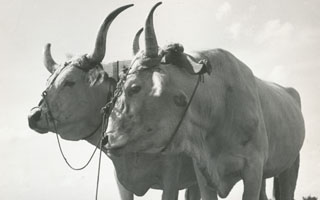THE FARM

The size of the farm was strictly correlated to the size of the tenant farmer family as well as to the number of draught animals required to plow particularly difficult terrain and transport manure and products in and out of the area.
Farms (sit) were the core units for the cultivation of the Bolognese plains. They were also called “possessions” (pussiòn) or “places” (lugh), depending on their size, which depended in turn on the size of the farming family (famàia d cuntadén) and the number of draught animals (tir d bu).
At the end of the 1800s, most farms were about 10-15 hectares or 50-70 tornature (turnadùra), a local unit of measure (5 tornature = 1 hectare).
Cattle were used both for working the land and for transporting material. The number of animals per farm was determined by multiple factors, including the nature of the soil, the number of days necessary for plowing, the required depth for planting and the crop rotation cycle (avinzòn).